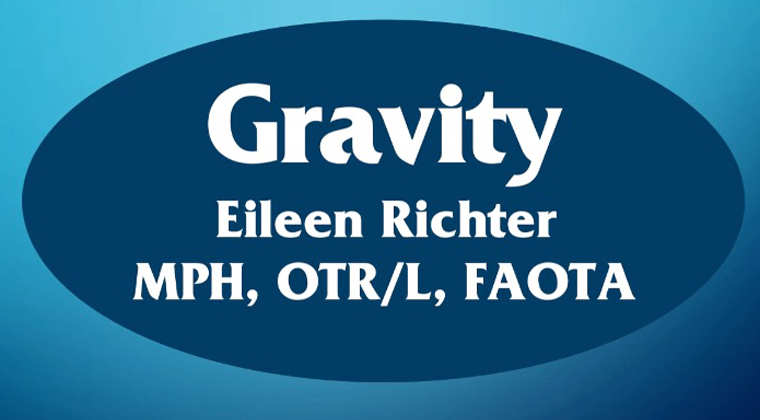Gravity - Summer 2020
Eileen Richter, MPH, OTR/L, FAOTA offers an in-depth course on the role of gravity in human development and function, providing deeper analysis than a live version.

Reflex integration and antigravity sensory motor development go hand in hand
Gravity influences infant development in many ways, from triggering vestibular processing to developing and strengthening muscles. Due to a number of factors, including improper positioning, lack of typical sensory motor opportunities, other environmental factors, and/or diagnoses of failure to thrive, autism, sensory processing disorders, etc., many of today's children are delayed in their sensory motor development when compared with past generations. These delays are particularly apparent in lack of core strength, proximal stability, and upper extremity coordination.
Along with other treatment strategies, gravity can be used by therapists to enhance development, especially in the areas of sensory motor processing, reflex integration and motor coordination. A variety of intervention strategies that engage vestibular mechanisms and take advantage of gravitational influences, including some innovative equipment, will be discussed and demonstrated via labs and video of children.
Objectives: following the course, participants will be able to

About This Course
This popular live course has been converted to an on-line format by request. The participant labs have been converted to demonstrations for viewers to follow and try themselves, along with analysis and discussion of therapeutic aspects of the lab activities. This feature provides more in-depth consideration than is available in the live version of the course.
Here's a brief outline of what to expect:
Module 1 - Introduction
Using a lecture format with slides and video, the role of gravity in human development and function is discussed. We’ll look at the purpose of reflex patterns and how they support our sensory motor progression from fetal development to upright posture and locomotion. This overview will include the ways reflexes influence sensory processing, muscle development, complex motor coordination and maturation of the brain.
Module 2 - Indicators
Module 2 describes the common barriers to antigravity development and the impact lack of antigravity integration on human behavior and performance from infancy through adulthood. Viewers will learn the indicators of poor antigravity development in the areas of sensory processing and modulation, sensory motor, and psycho-social function throughout the age span.
Module 3 - Basic Elements
We will begin our consideration of intervention strategies, by outlining the basic elements necessary to facilitate antigravity activation in infants and young children. The strategies will emphasize the areas of sensory input (vestibular, tactile and proprioceptive), motor responses and rhythmicity and include some demonstration.
Module 4 - Lab #1
The “Lab” modules are designed to encourage viewer participation. The module will include demonstrations of the activities; discussion of the therapeutic objectives and the value of the activities along with consideration of the treatment activities for adaption. Many examples of the activities with children are included. Module 4 Lab #1 focuses specifically on floor activities in prone.
Module 4 (continued) - Lab #2
Viewers will receive copies of all the activities that will be demonstrated and many more. Lab #2 specifically focuses on floor activities in supine and rolling. Rolling is a powerful activity for vestibular activation.
Module 5 - Clinical Reasoning
Deciding where to start in treatment and how to proceed can be very challenging considering the wide range of children’s needs with respect to sensory processing/sensory motor dysfunction. In this module we will discuss the neurobiological foundations for intervention; some important principles for therapeutic interaction; and recommendations for sequencing of strategies in treatment.
Module 6 - Lab #3
We’re back to more participant lab activities. In this case, we will focus on creeping on all fours. After demonstrations (and viewer experience with the activities), we’ll discuss the significance of this experience for antigravity development and future core and upper extremity function.
Module 6 (continued) - Lab #4
Activities in sitting will be our first activity focus upright against gravity. We will experience and consider ways to challenge gravity from this position to facilitate core strength and balance reactions. We will conclude the course with a summation of the physics of antigravity work and how to use it to support children who have not established good antigravity integration.
Welcome to Gravity ONLINE
About This Module
Appendix
Lab Worksheets
Additional Resources
Handout for Module 1
Introduction (part 1)
Introduction (part 2)
About This Module
Handout for Module 2
Indicators
About This Module
Handout for Module 3
Basic Elements
About This Module
Handout for Module 4
Lab #1 Floor Activities in Prone (part 1)
Lab #1 Floor Activities in Prone (part 2)
Lab #2 Floor Activities in Supine and Rolling (part 1)
Lab #2 Floor Activities in Supine and Rolling (part 2)
About This Module
Handout for Module 5
Clinical Reasoning
About This Module
Summary Handout
Lab #3 - Creeping on All Fours
Lab #4 - Activities in Sitting
Gravity Quiz
Self Evaluation
Course Evaluation